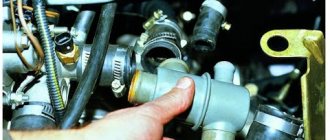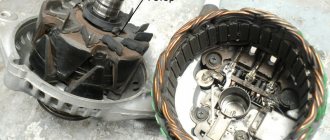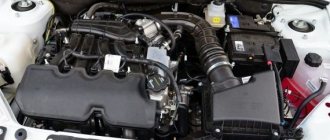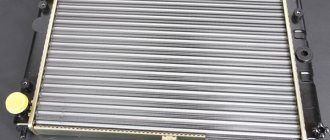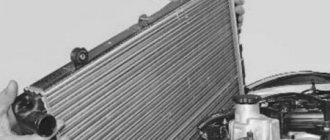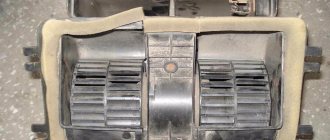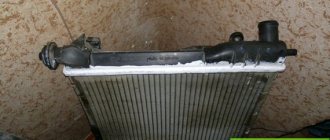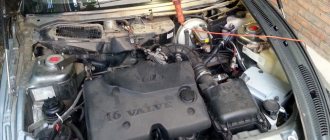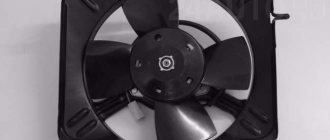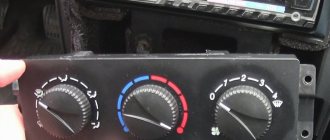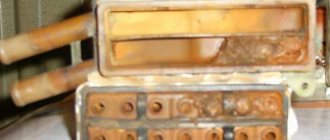Many motorists ask us why the lower radiator pipe is cold?
It is impossible to answer this question in one or more sentences. I had to write a whole article where everything was described in detail. You will find out what is the main reason for this, because with a heated engine this same pipe should not be cold. This situation indicates problems. Why is the lower radiator pipe cold - a question that is asked not only by beginners, but sometimes also by experienced motorists. Let's try to give complete information.
What could be the reason if the upper radiator hose is hot and the lower one is cold?
3 Good answer
Why doesn't the heater in my car heat well?
Heat from the stove is warmed air passing through the stove radiator. Coolant heated by the engine flows through the heater radiator. If the engine does not reach operating temperature (for gasoline engines, at least 60°), then the coolant is also not hot enough to heat the air. One of the possible reasons for underheating of the fluid or engine, and therefore the air in the cabin, is a faulty thermostat. A thermostat is a device that, when a certain coolant temperature is reached, opens the second circuit of the cooling system for more efficient cooling.
6 Good answer
I live on the 5th floor. Half of the battery is cold; when the water is drained, it heats up, then cools down again. What could it be?
This is a sign of insufficient coolant supply. It is a volumetric indicator. If you have not changed the heating device yourself, it means that the heat supplier (although variations are possible) has changed the parameters of the heat supply to your home (replacing pumps, connecting new buildings to the network, basic imbalance of the central network, clogging of the distribution unit of your home - there are a lot of options). Or it is possible that one of your neighbors on the riser replaced their heating radiators or wiring diagram - which led to an imbalance in your riser.
Have you changed all the sensors and thermostat, but the fan runs constantly when you start the engine?
Everything is simply checked using computer diagnostics. Most likely one of the two fan relays is stuck. Or the thermostat switch is faulty and incorrectly gives the temperature to the internal combustion engine. There are usually no other problems.
2 Good answer
What to do if your car overheats or boils?
You need to turn on the interior heater at full power. This will transfer some of the heat from the coolant to the heater radiator and help cool the engine. Do not open the radiator cap, the fluid is under pressure! If it drops sharply, the antifreeze will boil, and the stream of steam will scald you! You need to wait 20-30 minutes until the liquid cools down, then, throwing a thick cloth over it, carefully unscrew the radiator cap; if it is under pressure, you will hear a hissing sound. Check the cooling system for leaks at the hose attachment points. After the car has stood for about 30 minutes with the hood open, add water to the cooling system and continue on your way.
6 7 · Good answer
What to do if it’s cold at home and the radiators are barely warm?
If the temperature in the rooms reaches 18 degrees, then this is normal; you will have to buy an additional heater and dress warmer. If the temperature at home is below 18 degrees, feel free to contact the Housing Office/DUK/HOA. If in the past years or days it was warm, and then the temperature began to drop sharply, there is a possibility that one of the neighbors turned off the valve on their battery, in which case, urgently call the housing office/DUK/HOA or the heat and power company of your city.
Source
Why does the radiator pipe shrink and burst?
One of the dangerous manifestations of a malfunctioning cooling system is a violation of the geometry of the radiator pipes. Why is the situation dangerous if the inlet or outlet pipes of the radiator flatten when the engine has cooled down, and when warmed up they gradually return to their normal state? Why is this happening, can I solve the problem on my own?
About pressure in the cooling system
To effectively remove heat from the engine jacket, liquid cooling systems are hermetically sealed from the environment and can withstand pressure from 1.2 to 2 or more atmospheres. This is necessary to prevent the coolant from boiling when the temperature reaches 100°C. At elevated pressure, various brands of antifreeze and antifreeze can boil when heated to 107°C−120°C, and sometimes 150°C.
Technical means to increase pressure in the cooling system are not used. The required values are achieved due to a natural increase in the volume of heated liquid circulating in the “jacket” of a running engine. Excess pressure is released through the system expansion tank cap, equipped with special valves, in which a certain amount of air is always present.
Bends and cracks in radiator pipes
The excess air released during the expansion of antifreeze or antifreeze in the tank after stopping and cooling the engine is compensated from the atmosphere through the second check valve of the lid. If this does not happen, a vacuum is created in the tank, radiator, connecting pipes and engine jacket. The first to react to this by compression are the least durable elements of the system - the rubber radiator pipes.
The maximum possible value of negative (compared to atmospheric) coolant pressure depends on the temperature difference between the heated and cooled engine. It is no coincidence that motorists notice this problem in winter, when the temperature range is greatest. In this case, the pipes wear out quickly and, having lost their initial elasticity, can burst. The vehicle cannot be operated with such a malfunction.
Expansion tank cap: design features
In addition to the plastic body, threaded part and sealing gasket, the tank lid is equipped with two valves: inlet and outlet. Each of them is designed and must operate under certain conditions. The first opens at excess pressure - for example, 1.2 Bar. The second is needed to compensate for pressure when the antifreeze cools down. If this valve fails, a dangerous level of vacuum is created in the system.
The solution to the problem is to flush the valves or buy a new cap.
The metal parts of the valves may simply be clogged with dirt from the cooling system if it has not been flushed for a long time. In such cases, the problem can be temporarily eliminated by blowing and cleaning the lid valves. If there are repeated failures, you will have to start with a general flush of the entire cooling circuit. If the valve malfunction is due to corrosion of their metal elements, you should purchase a new cover.
How to identify a malfunction
In order to make sure that the radiator pipes are flattened precisely because of the strong vacuum in the cooling system, and the reservoir cap is to blame, it is enough to unscrew the latter a little (only on a cold engine). A characteristic whistle of incoming air will indicate a clogged or rusted check valve. If there is no whistle, you need to flush the entire system. In this case, it is better to start with the upper radiator pipe, which connects it to the expansion tank.
Why buying a new cover may not solve the problem
Unfortunately, the simplest part costing a few rubles does not always meet the requirements. The lid may not function due to a significant difference in pressure at which the valves installed in it open or close. You can check their serviceability and response threshold using a compressor for inflating tires, and adjust it by reducing the number of turns of the corresponding spring. Or simply buy and install a cover from another manufacturer.
The design of the VAZ 2110 cooling system
The main function of the cooling system is to maintain the engine operating temperature at 98-103°C. When the engine is running, the heat of the working parts is removed using coolant that constantly circulates in the system. While the engine is heating up, antifreeze or antifreeze moves in a small circle without passing through the radiator. The thermostat is closed at this time.
When the operating temperature is reached, the thermostat opens and the liquid circulates in a large circle. Both pipes become hot. The radiator promotes greater cooling by air flow. The fan increases the cooling intensity. The pump ensures continuous circulation. The thermostat regulates the amount of fluid supplied to the system.
For efficient operation of the VAZ 2114, 2115, 2110 engine, various indicators are taken into account:
- oil temperature;
- coolant temperature;
- outside temperature, etc.
The functioning of the cooling system is controlled by the engine management system, which collects all specified parameters.
A cold lower radiator pipe on VAZ 2110, 2114, 2115 does not always indicate a problem in the system. With a cold engine, before the large circle opens, it should not heat up, since hot fluid does not flow to the radiator. The thermostat can block circulation in a large circle in the cold season, when hot air from the coolant enters the car interior, causing it to cool faster. You need to pay attention to the cooling system if the radiator pipes remain cold when the internal combustion engine reaches operating temperature and it overheats.
Why is the lower radiator pipe cold on the VAZ 2110
Hi all! I can’t overcome overheating on my VAZ2110. The car warms up to a critical temperature 15 minutes after starting the engine. It started with the fact that the large circle did not open, the lower pipe was cold. The repairman immediately sent for the thermostat. Bought it, installed it. At first everything seemed to be normal, a large circle opened, the pipe was hot, but a little later the engine began to boil, and the pipe cooled down.
The lower part of the thermostat is boiling water, removed and checked in hot water - it opens, that means it’s working. But the pipe is cold! the master thought and thought, and said - the radiator is worthless, go buy a new one. Well, I stopped the horses here, let’s say, at least take it off and see what’s wrong with it. They took it off, poured water into the top hole, 3 liters went in, then water started flowing out. T.
E. The tubes are not clogged, as far as I understand. Why then is there no circulation?? In short, we also changed the cap on the expansion tank. Nevermind. As it warmed itself, it still warmed up. And there’s also the moment when you start the antifreeze in the tank rises and begins to splash out.
In general, the master says there is a microcrack in the cylinder head. You understand that changing is not a cheap idea. And after his sudden conclusions with the thermostat and radiator, I no longer know whether I can trust the master.
There will be comments for cons.
VAZ 2111. Tell me where to look? The car is overheating. The lower pipe is cold, the radiator is cold, the upper pipe is hot, cold air blows from the stove. The temperature is almost reaching the red zone. The level of antifreeze in the barrel rises. What's wrong with the thermostat or pump? The fan turns on almost in the red zone. 1.5 injector
No duplicates found
The thermostat needs to be replaced, it is jammed. you can try tapping it lightly
Change the thermostat. Everything is obvious.
The stove is on a small circle, yes. But it may not heat for other reasons. You can simply remove the thermostat and check it by throwing it into boiling water. If it opens, he'll be alive.
On the Priora, and these are the same eggs only from a different angle, it was similar. Cured by replacing the thermostat.
Check it out just in case. That's not for long. And if you change, put Kalinovsky. There are not many changes, but the effect is better.
It's not the thermostat. If cold air blows from the heater at idle, and warm air when revving up, it means the gasket between the block and the head has burned out. Other signs: if there is steam from the exhaust, the level of antifreeze drops when the internal combustion engine is running, there are air bubbles in the tank - remove the cylinder head.
Exhaust gases enter the cooling system: because of this, the antifreeze heats up and creates excess pressure. It depends on where the gasket burned out. I also suffered with 2110 at one time.
Your head gasket is fucked.
If the antifreeze starts to gurgle in the tank, it doesn’t necessarily mean that it’s boiling, it could be exhaust gases, there was a similar situation many many years ago back on the Volga, I suffered for a long time, and by all indications the car was boiling and overheating, no matter what I did, I changed several thermostats , in the end it turned out to be the cylinder head gasket that was to blame, although the level was normal and there was no steam coming out of the muffler
Guys, tell me I’m boiling. I go out to warm up for 2 minutes. I come arrow for red. changed everything sensors hoses radiator thermostat pump
Look at the new car.
Thermostat. I had this happen, and at -20. Oh, what a shame when the engine is at 90 degrees, and it’s cold from the stove ((
Most likely the cylinder head gasket came into contact. At high speeds there is barely warm air
It happened to me on Kalina, now it’s normal
Well, everything is obvious here - khan pomp
Oh vey! Is it really obvious?
Yes, it's simple)))) It's a damned place))))
“Vaz 2111. Tell me where to look?”
look towards normal cars. and this is a bucket. Well I do not know. Please adapt it for a flower bed.
Well, where is the logic? taken to carry. but doesn't carry. I won't even try to understand you.
Damn you on the head, eh!!
Now I’ll throw your Zhiguli full of minuses.
Open the fucking book on your vaz and there, on the fucking pages, there’s all the bullshit about your shit. You will learn what a thermostat is, an overrunning fan clutch, a pump, a fan belt, why you need an expander and a valve on the radiator cap, signs of a broken cylinder head gasket, cracks in the cylinder head, congestion and wear of the radiator.
No, damn, you have to ask this kind of shit here :(
Many motorists ask us why the lower radiator pipe is cold? It is impossible to answer this question in one or more sentences. I had to write a whole article where everything was described in detail. You will find out what is the main reason for this, because with a heated engine this same pipe should not be cold. This situation indicates problems.
Why is the lower radiator pipe cold - a question that is asked not only by beginners, but sometimes also by experienced motorists. Let's try to give complete information.
Causes of poor coolant circulation
According to the above diagram, the reason that the lower radiator pipe in the VAZ 2110, 2114, 2115 remains cold is the lack of fluid circulation in a large circle of the system. Note that the radiator is the main cooling element. Therefore, the upper pipe through which the liquid enters the heat exchanger will be hotter than the lower one, even if the liquid circulates correctly.
Possible causes of stagnation in the cooling system:
- radiator clogged;
- non-working thermostat;
- airlock;
- pump breakdown.
Any intervention in the engine cooling system requires subsequent flushing of the ODS and replacement of the coolant. Poor quality coolant cannot cope with cooling the engine and can cause a blockage in the system.
Thermostat
The problem may also be related to the thermostat. This device is small in size and has the ability to block coolant. As a result, problems occur, including those related to the cold pipe.
By the way, the problem with the thermostat also affects the upper pipe. It can also be cold, but the bottom one, on the contrary, can be hot. All this taken together cannot in any way indicate the normal operation of the entire cooling system.
Drain the liquid from the thermostat, loosen its bolts and remove the device.
As a result, we gave three main reasons why this happens. Thus, having found out why the lower radiator pipe is cold, we draw the appropriate conclusions and act according to the situation.
Hello, sorry for the trouble. Could you help with one question? In general, the VAZ 1118 car’s heater does not heat well; one might even say it blows cold even though the engine has heated up to 80-90 degrees. I've already replaced a bunch of expansion tank caps. Does not help.
I had such a problem once, after watching your videos (for which special thanks), I removed the airlock and the stove blew perfectly. Now I can't get the air out. When I bring the fan to fire and open the cover of the engine, the antifreeze rises sharply, begins to boil and flow out, and it seems that the engine is not cooling down. I turned off the car, tried the pipes, and realized that the lower pipe from the radiator was cold, the upper one was so hot that it burned my hand.
I recently changed the pump because it was leaking, and the antifreeze was completely gone. When they changed the antifreeze at a service station, the car warmed up from 0 to 90 in 40 seconds, and the stove was blowing ice, they did something there, raised the front of the car, the plug went away, the stove started blowing well. Luzar bought the RB cover yesterday.
Tell me what could be the problem, where to dig? And why, when I open the cover of the RB while turning on the fan, I hear a strong splash and the antifreeze boils and flows. After all, you don’t have this in the video. The air was expelled normally and that’s all.
Removing the air lock
Signs of the formation of an air lock in the cooling system are rapid warming up of the car to high temperatures and poor performance of the interior heater. This can be especially easy to notice in winter. The reasons for the appearance of an air lock are different:
- incorrect filling of coolant;
- engine overheating;
- depressurization of the system;
- damage to some parts, etc.
If, during the inspection, leakage of antifreeze (antifreeze) is detected in the system, traces of coolant on the engine or other places, the causes of the leak should be eliminated. Often depressurization occurs due to poor tightening of clamps on pipes and hoses. They need to be tightened up. Any deformed or faulty parts found should be replaced.
There are several ways to remove air pockets. The easiest one is to drive up a steep hill with your face up. Unscrew the radiator and expansion tank caps. Let the car warm up for 10-15 minutes. Then release the gas a little and fill the system with coolant to the required level. Continue until bubbles stop appearing.
In VAZ 2110, 2114, 2115 cars, airing is rare. The cause of similar symptoms may be clogged hoses or radiator.
Possible problems with the engine cooling system and how to fix them
The main causes of problems in the cooling system include:
- poor coolant circulation;
- formation of an air lock;
- radiator contamination;
- thermostat failure.
Causes of poor coolant circulation
If the fluid circulation system operates correctly, the lower radiator pipe on the VAZ 2114 will always be colder than the upper one. The most common cause of system blockage is poor-quality coolant. To fix the problem, you need to buy new antifreeze and flush the entire system.
The best products on the automotive chemicals market now are G 12 class antifreezes. Modern carboxylate technology is used in their production.
Reasons for the formation of an air lock
Warming up the engine too quickly to high temperatures and an unstable interior heater are the first signs of an air lock in the cooling system. First of all, these bells are easy to notice in winter.
The reasons for the formation of air locks include:
- car engine overheating;
- breakdown of parts;
- violation of the sealing of the cooling system;
- Incorrect coolant filling.
There are several ways to remove an airlock. The simplest is to place the VAZ 2114 on a steep hill with the hood up, unscrew the radiator caps and warm up the car for 15 minutes. Then press the gas several times and fill the system with coolant. Wait for the bubbles to settle.
Dirty radiator
This is one of the main reasons for the failure of the cooling system, and, as a consequence, the cold lower radiator pipe on the VAZ 2114. Due to the fact that this device is located in front of the car, various debris, rust, and insects constantly get into it.
For an uninterrupted cooling system, it is very important to regularly carry out radiator maintenance.
If contamination is detected, you must either clean the radiator yourself or purchase a new one.
Thermostat failure
If the thermostat fails, the coolant stops circulating throughout the system. The lower pipe does not heat up even when the refrigerant temperature reaches 85-90 degrees.
If a malfunction is detected, the thermostat should be replaced in the following order:
- Drain the refrigerant.
- Unscrew the air filter.
- Disconnect the radiator hoses.
- Open the thermostat cover.
That’s all the answers to the question: why is the lower radiator pipe on the VAZ 2114 cold?
Why is the lower radiator hose cold? List of possible problems and how to fix them
Why is the lower radiator hose cold?
- a question that is asked not only by beginners, but sometimes also by experienced motorists. Let's try to give complete information.
Beginners often make the mistake of believing that the lower pipe should never be cold, and they begin to sound the alarm.
Cleaning or replacing the radiator
The radiator, located in the front of the car, absorbs the main flow of dust and dirt. For its effective operation, timely prevention and cleaning is necessary. The radiator can become dirty both inside and outside.
An indicator of internal cleanliness is the condition of the coolant. Manufacturers recommend changing antifreeze every 75,000 km or every 5 years. However, a change in the color of the liquid, severe darkening, discoloration, or the presence of rust requires urgent replacement of the coolant. It is recommended to change antifreeze at least every 40,000 km.
To carry out internal cleaning of the cooling system of VAZ 2110, 2114, 2115, it is necessary to drain the liquid. Sequencing:
- open the expansion tank cap;
- place a container to drain the antifreeze;
- Unscrew the drain plug from the cylinder block;
- drain the refrigerant;
- unscrew the radiator drain plug (located at the lowest point);
- drain the remaining antifreeze (antifreeze);
- tighten all the plugs.
To clean, pour distilled water into the system and start the engine for about 20 minutes. Ordinary water contains many impurities and forms scale, so its use is undesirable. The liquid is drained several times until clean water flows out. This method is ineffective as it removes a small amount of deposits.
For more effective washing, it is advisable to use special chemical additives. The detergent components included in their composition allow you to dissolve deposits and remove various types of contaminants. The mixture of water and vinegar used by many motorists is less effective. It does not remove all deposits. After using chemicals, the cooling system is washed with distillate.
After cleaning the entire SOD of the VAZ 2110, 2114, 2115, an additional internal flushing of the radiator is carried out. To do this, you need to detach the hoses from the base and the upper and upper tank. Liquid is poured into the radiator through the upper pipe using a garden hose. Flushing is carried out until clean water flows from the lower pipe.
The removed radiator can be externally cleaned to remove dirt, insects, and sand from the cooler honeycomb. Cleaning is carried out with a soap solution or special devices that create a strong flow of water or air, for example a Karcher vacuum cleaner. The procedure should be carried out carefully so as not to bend the radiator honeycombs.
If damaged or heavily soiled, the radiator should be replaced.
Replacing the thermostat
If the thermostat valve does not operate correctly, the coolant does not circulate throughout the large circle of the ODS. The lower pipe remains cold even after the refrigerant is heated to 90°C. The top pipe may be hot due to steam escaping. The thermostat can also get stuck in the open position; in this case, the engine does not warm up to the required temperature or takes too long to warm up.
In preparation for replacing the device, it is necessary to drain the fluid from the system and remove the air filter. Then the radiator and fluid pump hoses are disconnected from the thermostat housing. After this, loosen the mounting bolts and remove the thermostat cover. The device is replaced with a working one. Attaching the thermostat is done in the reverse order.
These are the main reasons for the malfunction of the cooling system and the cold lower pipe of VAZ 2110, 2114, 2115 cars.
Source
Dirty radiator
The main reason for this, according to most experts, is a clogged radiator
. Over time, this important element of the cooling system becomes clogged with rust residue, dust, leaves and other debris. The location of the radiator is in front of the car. So, no matter what happens, it gets inside. Ultimately, all this leads to problems.
Since this reason is the most important, below is a method on how to clean a radiator. In addition, proper care of the radiator and its regular maintenance ensures the normal operation of the entire cooling system.
Once it has been decided to start by flushing the radiator, to eliminate the symptom described above, proceed in different ways:
- Or they go to the store and buy a new radiator;
- Or you can clean it yourself.
Important points:
- The radiator must be cleaned when the engine has completely cooled down;
- It is recommended to wear protective gloves and firmly fasten the car hood;
- All coolant is drained from the radiator and checked. If the liquid is perfectly clean and there are no traces of rust or scale in it, the radiator is clean and the reason for the cold pipe is different;
- If the liquid is dirty, then that's it. Pour clean water (necessarily distilled) inside. We start the engine and let it run for 20 minutes.
- We drain the water, check for cleanliness and, if necessary, repeat the procedure several times.
Coolant replacement
: Often, when replacing the coolant, beginners make a mistake and then complain about a cold pipe. This concerns a situation where the radiator itself is freed from old fluid, but the tank is forgotten. As a result, this affects the entire cooling system. It starts to act up and diagnostics give no clue.
How to determine if the engine is overheated
At first glance it seems very simple - according to the indicators of the engine temperature device, or - sensor. This is true, if not for one thing - novice motorists are so captivated by the road situation around them that they look at the instrument panel only in one case - how much fuel is left. Experienced motorists, on the contrary, due to their confidence in their abilities, also do not look at the car’s dashboard. And as a result, a situation often arises that overheating is detected when the engine temperature has long exceeded permissible limits, and irreparable damage has been caused to the engine. It is irreparable overheating that is one of the most complex malfunctions, which leads to very serious consequences. But more on that later.
What to do if the engine overheats
First of all, it should be remembered that if the overheating is short-term (for example, the temperature needle rises in a traffic jam), then you should observe whether the temperature will drop after you start driving (counter air flow appears) or as a result of turning on the radiator fan.
If the car was already in motion and the engine temperature reached a critical level, you should not immediately turn off the engine. Also, you should not try to cool the engine by pouring water on it from outside, pouring cold water into the radiator, etc. Such actions will lead to the need to repair the internal combustion engine, and it may be necessary to change the BC and cylinder head.
Next, you need to wait a few minutes, while simultaneously inspecting for obvious and strong signs of antifreeze/antifreeze leakage under the car or in the engine compartment. If no leaks are visible, but the temperature does not drop, the unit must be turned off.
Please note that you need to immediately turn off the engine when steam starts coming out from under the hood; traces of intense coolant leakage are clearly visible. In this case, the engine must be stopped, without expecting that turning on the stove will reduce the heating.
Reasons that can cause overheating
1.Lack of coolant. The liquid in the engine boils not because there is not enough of it, but here’s why: remember about the outer surface for cooling? If there is a lack of fluid, the contact surface between the fluid and the heated engine is insufficient, and heat transfer to the environment is poor. This is where the overheating comes from. The engine cooling system is not sealed, as many believe, and fluid evaporates during operation - do not forget to check its level regularly. And of course, monitor the condition of the radiator and pipes - leaks are unacceptable. There are cases of internal leakage - as a result of damage to the gasket between the head and the cylinder block. Water will not flow out of the exhaust pipe, but a constant decrease in the fluid level without visible leaks is a reason to be wary and contact a specialist. Water accumulated in the cylinders at the moment of starting the engine can lead to water hammer - this can literally destroy the piston group, and not only that.
2. Radiator condition. The gaps between the radiator honeycombs are quite small and can gradually become contaminated by representatives of the insect world. This is not a joke; there was a case when minor contamination of the radiator (coupled with the poor condition of the engine) led to constant overheating of the car. Keep the radiator clean and blow it with compressed air at least occasionally.
3. Incorrectly set ignition angle. If the ignition angle is violated, the fuel combustion process is disrupted. As a consequence, an increase in combustion temperature and a decrease in power. The power has dropped, but there is no need. What are we doing? That's right - press the gas pedal harder. It turns out that more fuel is spent on the design operating mode of the engine (at which normal cooling occurs). Hence the overheating. By the way, an ignition problem can arise (spontaneously, and not after your intervention in the finely tuned engine mechanism) if the timing belt or chain is stretched. This is not the only possibility, but it is common - keep in mind.
4. Fuel quality. An inappropriate octane number leads to a decrease in power and an increase in the temperature of fuel combustion. There is only one way out - refuel in one place, so the likelihood of getting bad gasoline is lower.
5. Deposits on the walls of the engine and radiator. The reason is simple - the use of low-quality coolant, or even water. A little more detail. From a physics point of view, using water is better, since water has better thermal conductivity than alcohol-containing antifreeze. But - there are salts in the water (you can see them on the walls of the kettle) - the same thing happens inside the engine. As a result, water circulation is disrupted, cooling efficiency is reduced and the engine overheats. If you are pouring water into the expansion tank, pour distilled water, it is free of salts. It is best to use special antifreeze. Believe me, it is impossible to completely remove scale from the engine. And one more “beauty of water: if, after water, for example in winter, you fill in antifreeze - be prepared for drips (it can leak anywhere: radiator, pipes) - this is a fact. If you constantly drive “on antifreeze,” nothing will happen, but after water, antifreeze will flow 99%.
6. Engine wear. This can include many aspects, but in most cases it is wear of the piston group. During long-term use of the car, the piston rings, which serve to seal the combustion chamber, wear out, which leads to a decrease in compression, impaired fuel combustion, loss of power (remember the formula) and overheating of the car.
Radiator pipe: possible malfunctions, replacement features
The radiator pipe is one of the key elements of the cooling system of a car engine.
We’ll talk about this topic today: types and classification of pipes, possible breakdowns and ways to eliminate them; design and installation features. The engine cooling system consists of many main and auxiliary elements that provide cooling of the fluid, its circulation and connection of elements through hoses. To connect hoses, several pipes are provided on the system elements, connecting all devices into a single whole.
